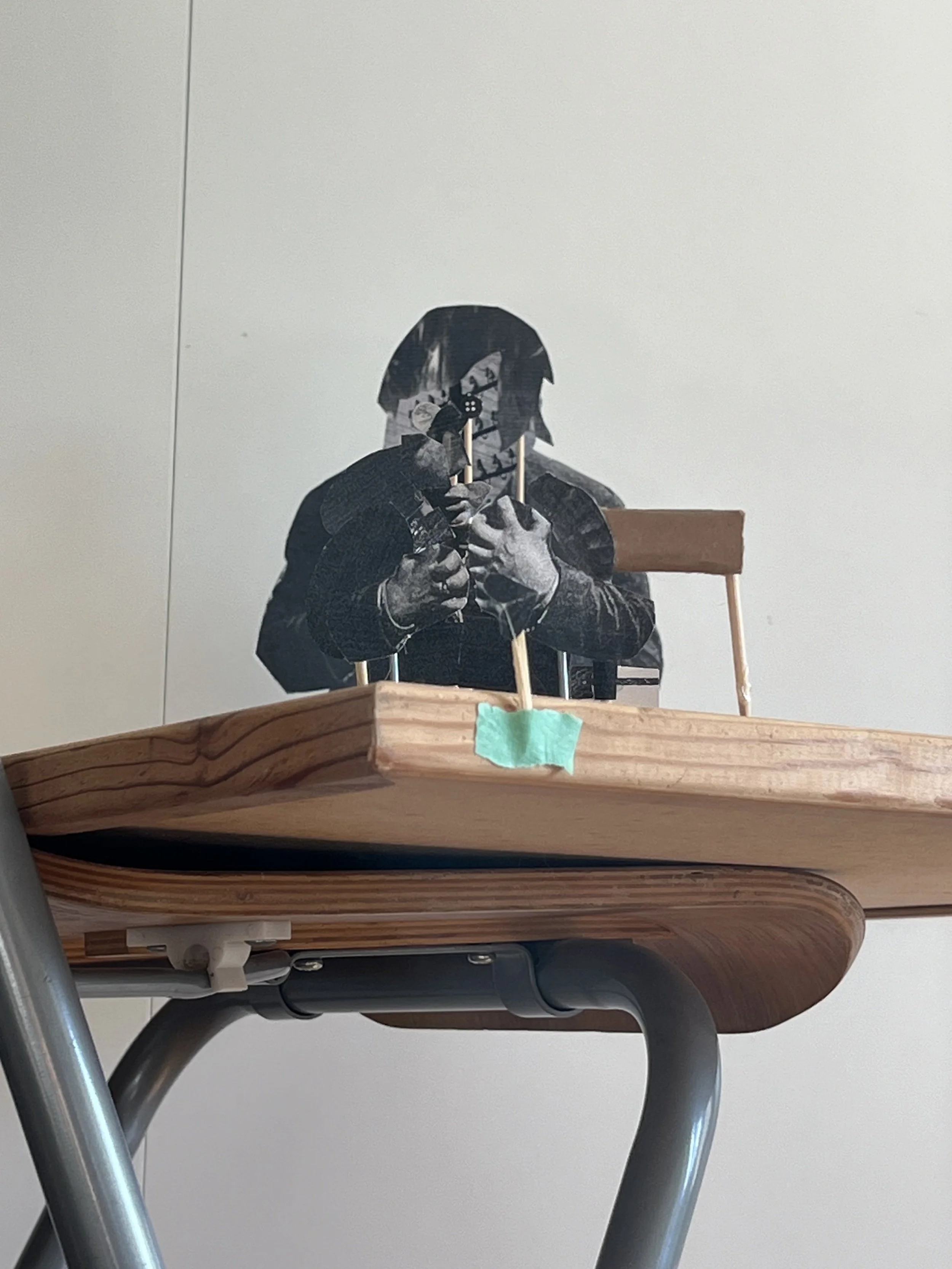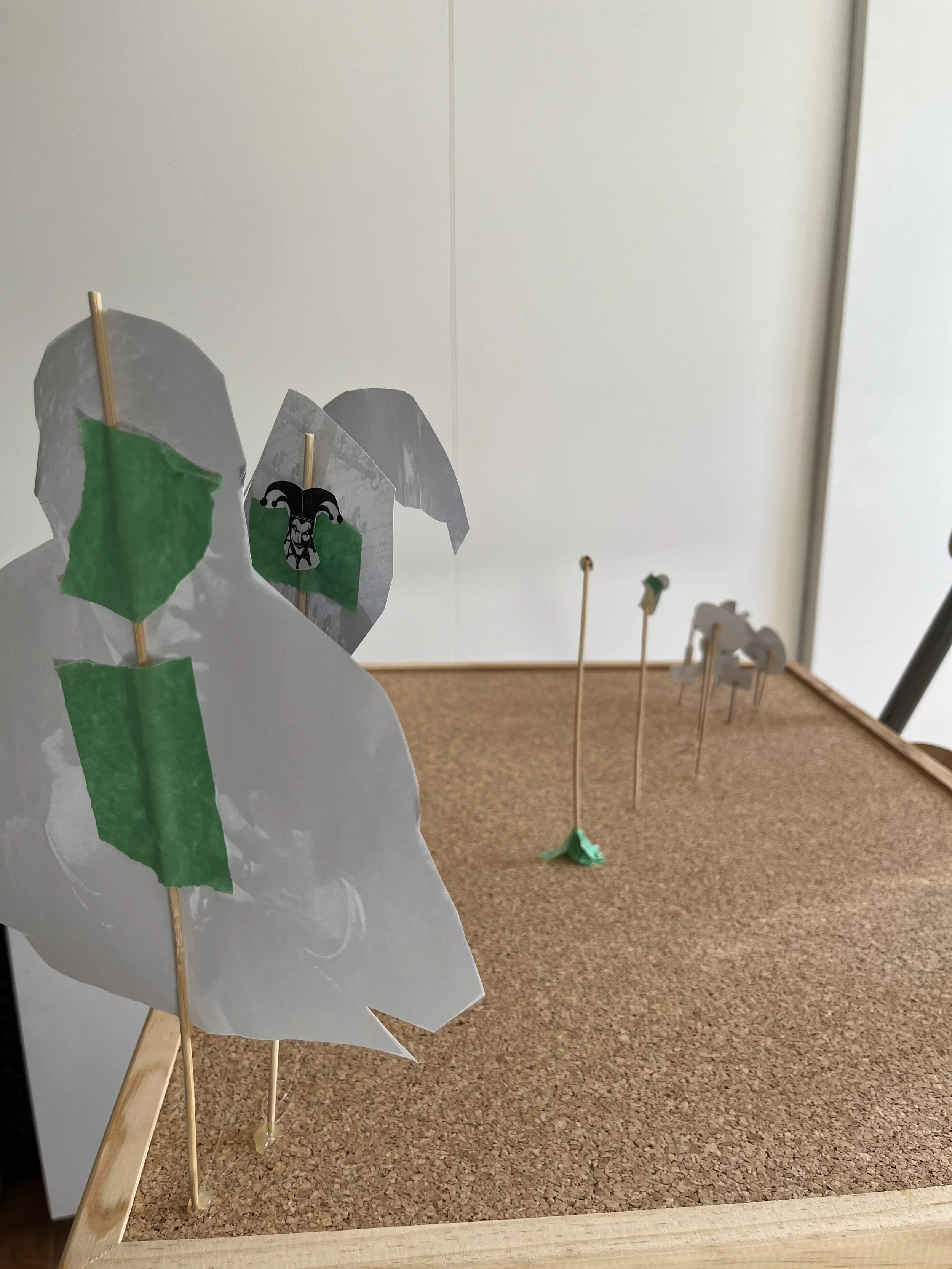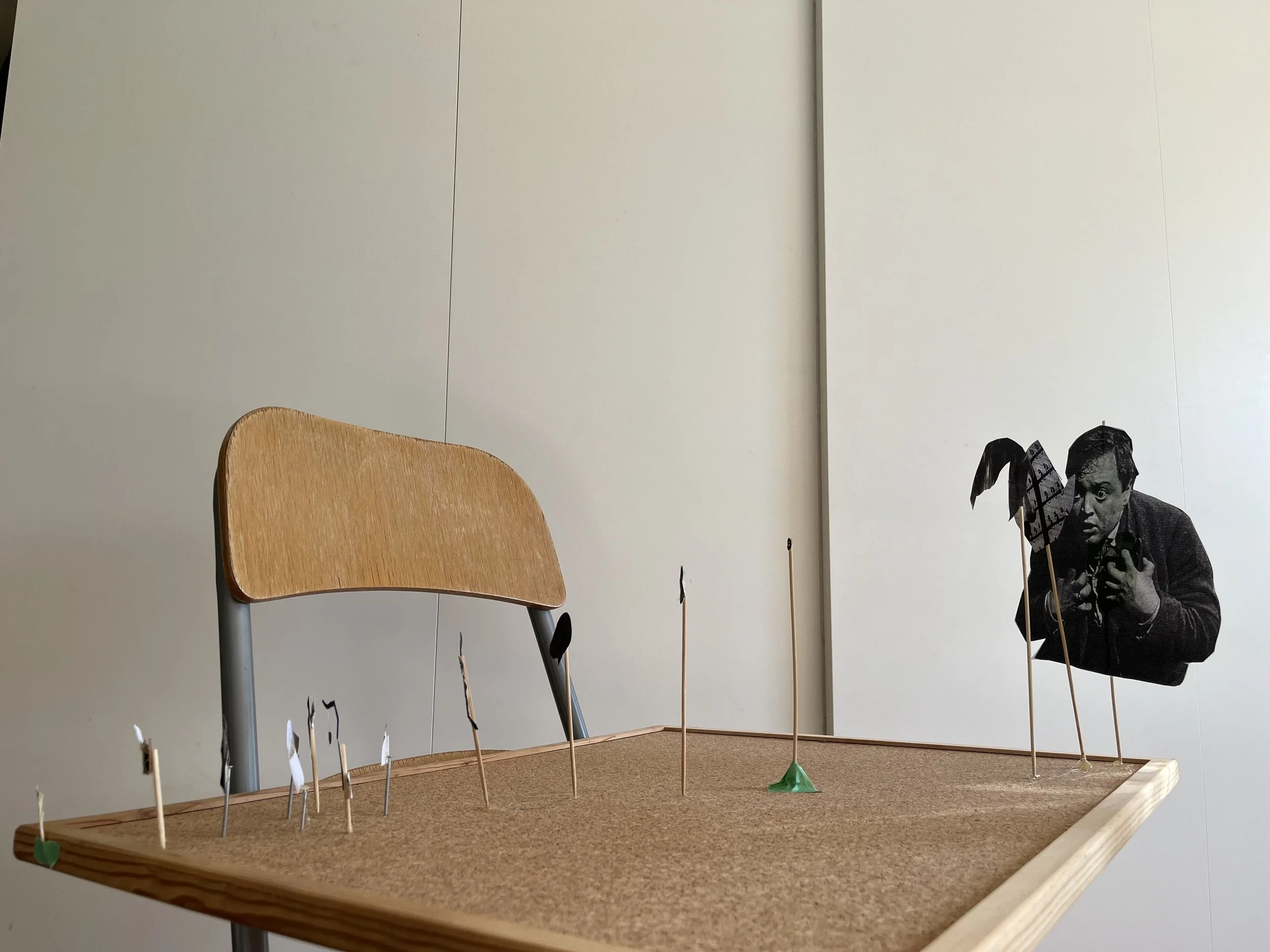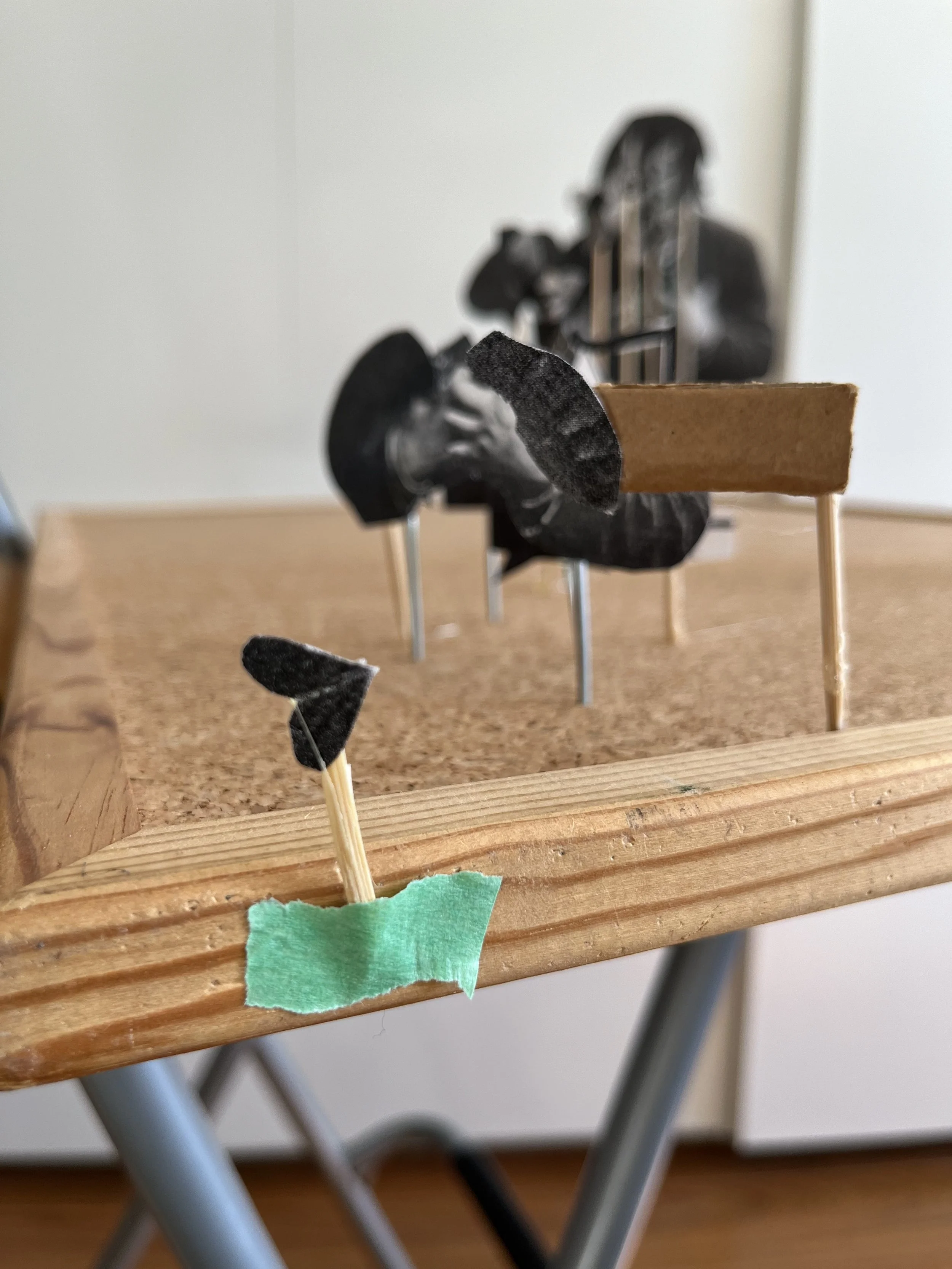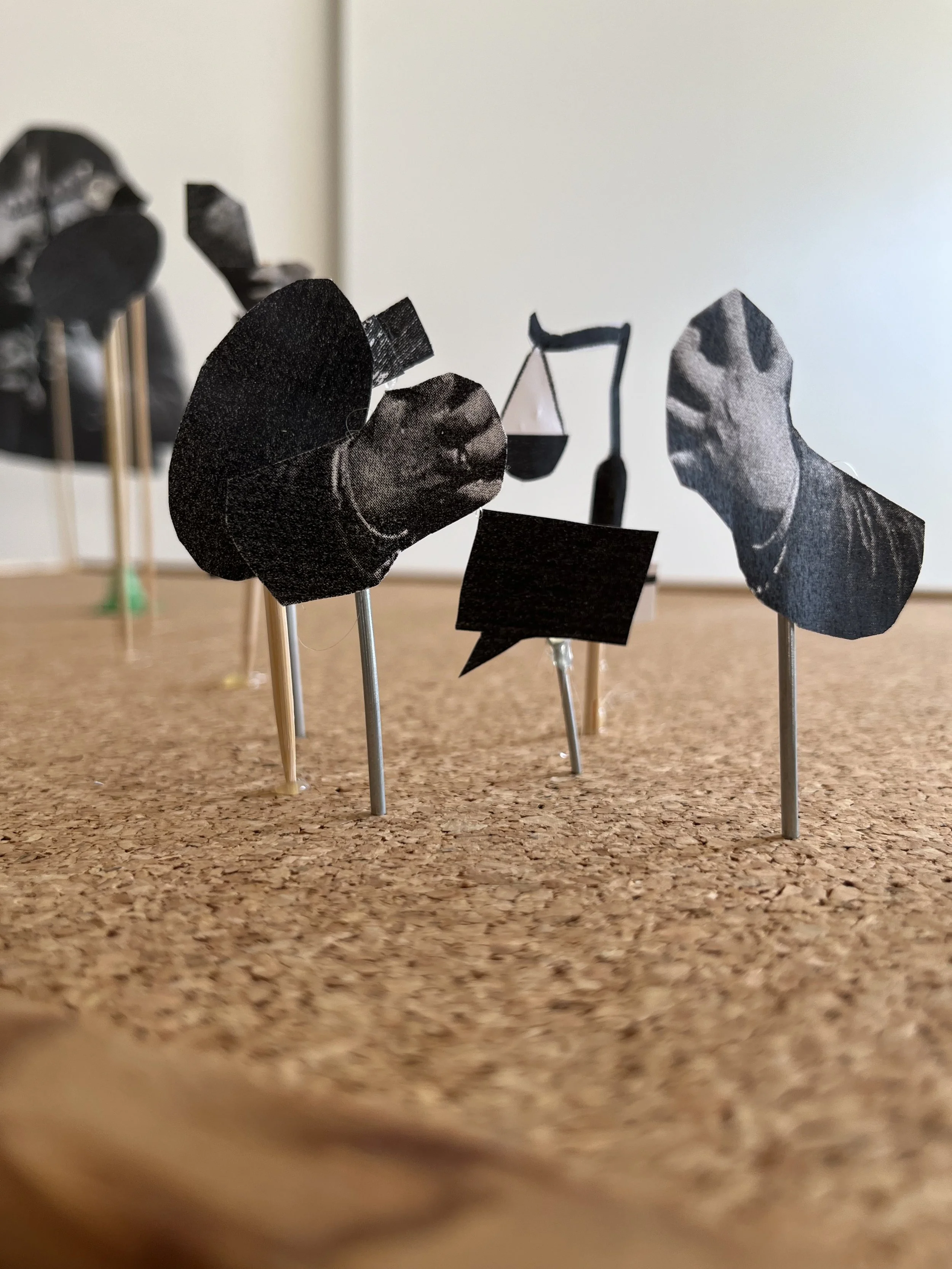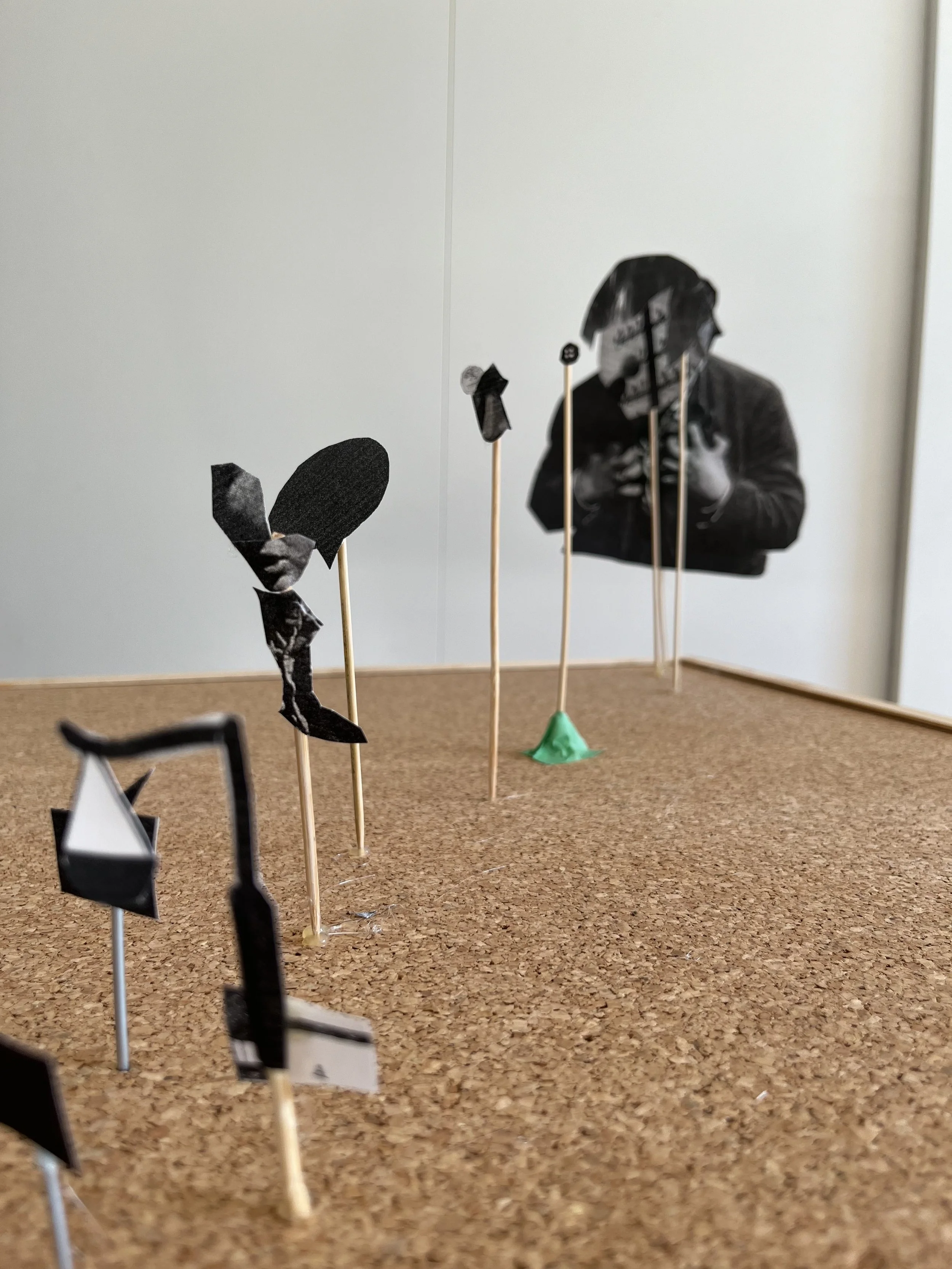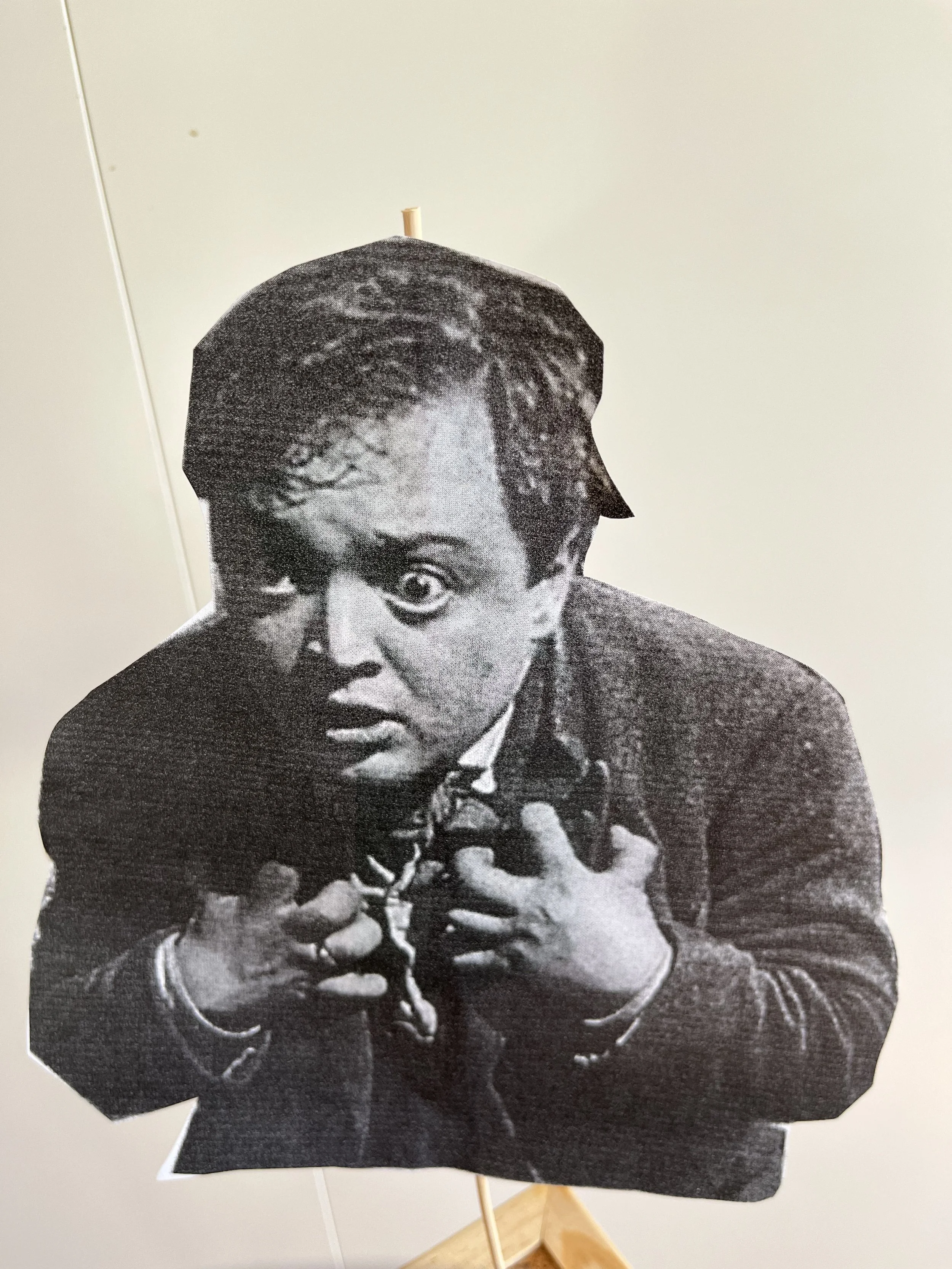Lorre Lore
Lorre Lore
Stanford Hu
Abstract
Lorre Lore is an anamorphic art piece, comprised of snippets of paper attached to sticks and nails to a cork board which, when seen from a specific angle and direction, amalgamate to an image of Peter Lorre as Hans Beckert in the Kangaroo Court scene of Fritz Lang's M. The piece explores aspects of Beckert’s identity in connection to how humans portray and understand each other’s identities. Each of the thirteen unique components and their positions explores the different representations and understandings of identity in M (Lang), Clothes Make the Man (Keller), and Toni Erdmann (Ade). The distance from the vantage point, different perspectives of the piece, and sizes of the components that make up Lorre Lore work together to tell a story about the process of evaluating Beckert's identity and speak to the methods of identity construction as a whole.
Fig. 1: Lorre Lore. Artwork by Stanford Hu, 2024.
Fig. 2: Lorre Lore. Artwork by Stanford Hu, 2024.
Fig. 3: Lorre Lore. Artwork by Stanford Hu, 2024.
Fig. 4: Lorre Lore. Artwork by Stanford Hu, 2024.
Fig. 5: Lorre Lore. Artwork by Stanford Hu, 2024.
Fig. 6: Lorre Lore. Artwork by Stanford Hu, 2024.
Fig. 7: Lorre Lore. Artwork by Stanford Hu, 2024.
Fig. 8: Lorre Lore. Artwork by Stanford Hu, 2024.
Lorre Lore is a perspective art piece in reference to Fritz Lang’s M, Gottfried Keller’s Clothes Make the Man, and Maren Ade’s Toni Erdmann. The focus of the piece is to explore the aspects of Beckert’s identity in M and connect that to how humans portray and understand each other’s identities. Lorre Lore is a collection of different images printed on paper attached to sticks and nails which, when seen from a specific angle and direction, amalgamate to an image of Peter Lorre’s Hans Beckert in M. This amalgamation of Beckert can be seen when viewing the canvas from underneath and 40cm away from the bottom left corner.
The varying materials used—hot-melt adhesive, wood glue, painter’s tape, as well as the heights of each bamboo stick or nail—add to the narrative of how different aspects of a person’s identity are more reinforced by societal expectations. Furthest away from the image of Beckert, and closest to the viewer, is a cut-out of a paper heart weakly stuck to the side of the foundation of the piece with painter’s tape. The different methods and materials used in Lorre Lore suggest how there are varying strengths to how important different ideas and aspects of his identity are to him, and as viewed by others. The most significant aspect of this work is the discourse on the components of identity and the unique approach toward presenting this discussion. Furthermore, each component’s location, scaffolding under it, and size all have carefully thought-out underlying ideas that create meaning through the entire representation of Beckert and add to the overarching debate of identity.
The components are combined to create a “wholistic” image of Beckert but only when viewed from a certain perspective. I chose this medium because the aspect of perspective ties closely with the idea that people’s true identities are difficult to find, sometimes impossible even for themselves, and can only be truly understood when you know how to approach it. Most importantly, the positioning of the perspective where the entire image of Beckert can be seen imitates the kneeling that Beckert performs in the kangaroo court scene in M but also how it is often difficult, or even impossible, to be able to judge someone’s identity perfectly. Furthermore, these ideas combined with the “craft-related” materials used for this work come together to show that oftentimes our identities are weakly put together, where a simple gust of wind could blow it down. Lorre Lore speaks to a narrative of careful construction and constant change since our identities are always malleable and changing, dependent on both our environment and our own actions.
My collective portrait of Beckert is composed of thirteen unique components, one of which is not observable from the viewing perspective:
Hair of a Kukeri: As a direct reference to Toni Erdmann, the Kukeri is a reference to chrononormativity and what our appearances can say about identity. Additionally, hair is often a very key part of the appearances of people and is an aspect that can usually be manipulated by the wearer—symbolizing the extent of our control on the evaluation of our own identities.
Button: The button represents how clothing is an aspect of identity, as explored in Clothes Make the Man and Toni Erdmann. Additionally, its proximity to the coin should be noted, hinting to how closely clothing is related to wealth. Finally, the button and the coin are in place of Beckert’s eyes because wealth and clothing are typically the first two components seen and pursued by people.
Coin: In addition to the above, the coin is the Euro, making reference to nationality and how geographical location dictates our identity.
Nose from The Nose: Nikolai Gogol’s The Nose explores similar ideas to Lang’s M, such as the expectation of identity as a member of a certain group. The gang members in the kangaroo court scene of M explore this narrative of whether people should act a certain way or are entitled to act a certain way due to what activities they partake in and their background, identical to The Nose. Furthermore, including a sentient being as part of Becker’s face draws a parallel to his argument that an autonomous force within him is compelling him to commit murder and not himself.
Speech bubbles: The most firmly fixed components are the speech bubbles, nailed down and hot glued, which are used to represent the strongly fastened ideas of Beckert’s image based on the conversations, ideas, and explanations passed around by his environment. It also draws parallels to the ideas of how society determines our identities. This piece makes references to our performance of identity, such as seen in Clothes Make the Man, Toni Erdmann, and “The Emperor’s New Clothes” (Hans Christian Anderson).
Snippets of Beckert: To an extent, Beckert is himself, and being himself influences his own ideas and actions to become who he expects himself to be. This self-expectancy, also heavily explored in Clothes Make the Man, is vital to everyone’s everyday actions and is therefore vital to who he will become. Furthermore, the snippet of his mouth makes reference to how perhaps what he says during the kangaroo court is true and should be a part of his identity.
Hands: Beckert’s hands, as seen in the movie, represent the brutality of his murders and how much they are tight and irremovable aspects of his identity, as symbolized by the nails to which they are stamped down by. It is intended to create discourse on how our actions dictate our identity and how it is difficult to look past people’s actions such as in the case of murder.
Half of a Scale: The scale incite discussion on truth and justice, as explored in M. Only including half suggests the unfairness of his trial in a kangaroo court and the unfair judgment of another’s identity when different perspectives are not considered.
Toni Erdmann’s Veneers: The veneers reference Winfried Conradi’s theatrical display of performance about the people he observes in the film Toni Erdmann. The determination that people will act a certain way due to societal expectations is explored heavily throughout M and Fritz Lang’s other works. I believe Fritz Lang would have enjoyed Toni Erdmann not just because of the discourse on the performance of identity, but also because of the style of long shots, non-diegetic sound, and many other techniques like ones that he himself implemented in films such as M.
Parts of Panopticon Blueprint: The panopticon refers to a unique circular prison architecture designed in the late 1700s by Jeremy Bentham, whereby inmates can be viewed on all sides by a prison guard located in a central viewing platform. The implications of this architecture, discussed by Michel Foucault in Discipline and Punish, are that inmates act differently because they could be constantly under observation. The panopticon was included to connect with ideas such as indexicality, such as explored in Kata Gellen’s “Indexing Identity” article on Lang’s M, and refer to how Beckert’s actions are determined by his evasion from the police. In “Indexing Identity,” Gellen suggests indexicality is used both narratively and thematically in M to add to the investigation behind the murders and to draw parallels between the Beckert’s identity and his true self. Gellen also questions the credibility of a purely tangible approach to understanding one’s true identity and motivations.
Heart: The furthest piece from the “real” Beckert, and most weakly attached to the piece, connected merely with a broken piece of bamboo and loose painter’s tape. It presents the argument that when people observe Beckert;s actions, the last words that would come to mind are ideas related to love and affection as represented by the heart. However, through Beckert’s own eyes, these may still be ideas true to who he is, as he is still human and his actions are not truly defining of his intentions.
Clown: The clown is not seen from the viewing point but is still an extension to show how our own appearance can be an “act”. It is also making references to the ideas of carnivalesque explored in Clothes Make the Man and Toni Erdmann. Additionally, the clown illustrates that our self-image, which is unobservable to others, may be a masquerade even to ourselves—despite being ourselves, we sometimes are still unable to truly understand our own habits and behaviours. Specifically, the clown and the heart come together to show that there are vast differences between our own perception of ourselves and what others would consider the “true” version of ourselves.
Balloon scene: As the backdrop for the majority of Beckert’s face, the balloon scene represents the actions and ideas that only he has seen—and by default representing how everyone in the world has gone through their own unique experiences. These experiences are something close to you, painting the backdrop of who you are and what you are—something you cannot get rid of nor want to get rid of.
Lorre Lore is filled with details that could be discussed for hours and is meant to provoke self-reflection on our perception of identity. Overall, the artwork shows that the pursuit to concretize an identity for ourselves and others is something that we will never finish; rather, it is the actions that we perform to do so that illustrates that very identity. I hope viewers of my work will feel compelled take a moment and self reflect on what aspects of their lives really define who they are. Perhaps the perfect phrase that summarizes these ideas and simultaneously sparks more discussion on the topic is said by Beckert himself in the kangaroo court scene of Fritz Lang’s M: “I can’t. I can’t escape from myself” (1:42:51).
Works Cited
Andersen, Hans C. “The Emperor’s New Clothes.” H.C. Andersen Centret, 2019, andersen.sdu.dk/vaerk/hersholt/TheEmperorsNewClothes_e.html.
Foucault, Michel. Discipline and Punish: The Birth of the Prison. Translated by Alan Sheridan. Vintage Books, 1977.
Gellen, Kata. “Indexing identity: Fritz Lang’s M.” Modernism/Modernity, vol. 22, no. 3, Sept. 2015, pp. 425–448, https://doi.org/10.1353/mod.2015.0053.
Keller, Gottfried. Clothes Make the Man. University of California Press, 1977.
M. Directed by Fritz Lang, Nero-Film, 1931. Kanopy. Web. 20 Apr. 2024.
Toni Erdmann. Directed by Maren Ade, Mongrel Media, 2016.
Stanford Hu is an undergraduate student at the University of British Columbia studying Psychology and Law and Society, hoping to explore more about the connections between human behaviour and society.
Picture: Lorre Lore. Original artwork by Stanford Hu.

